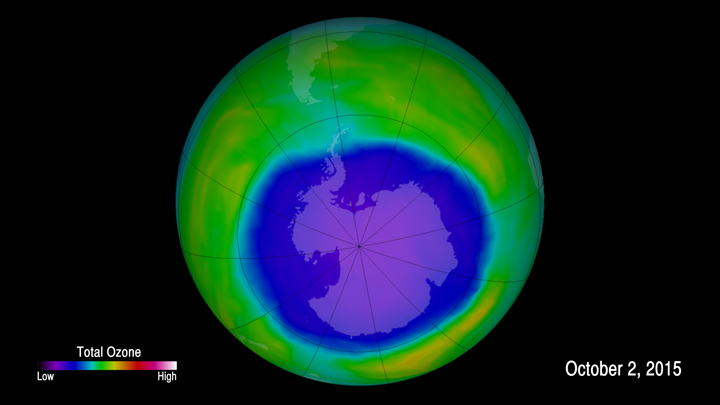While you may have thought the ozone hole was mended after the ban of harmful ozone-depleting gases, it’s still there. And this year scientists say not only is it bigger than expected, but it showed up later than expected.

NASA and the National Oceanic and Atmospheric Administration (NOAA) found that the ozone reached its peak at 28.2 million square kilometres on Oct. 2, an area that is larger than North America. The hole peaked at 24.1 million square kilometres on Sept. 11, 2014.
READ MORE: Four new gases found in ozone layer
Using the 1991-2014 period, this year’s ozone hole was the fourth largest on record.
But there’s no need to panic.
“While the current ozone hole is larger than in recent years, the area occupied by this year’s hole is consistent with our understanding of ozone depletion chemistry and consistent with colder than average weather conditions in Earth’s stratosphere, which help drive ozone depletion,” said Paul A. Newman, chief scientist for Earth Sciences at NASA’s Goddard Space Flight Center.
Still, that doesn’t mean all is good.
- Ontario First Nation declares state of emergency amid skyrocketing benzene levels
- Singh mulls TikTok return as U.S. nears potential ban over security fears
- More financial institutes are offering crypto-services, survey shows
- Possible TikTok ban in U.S. looms after Biden signs bill, setting up legal fight
Now, if you were around for the 1980s, you’ll remember that scientists discovered that there was major ozone depletion over Antarctica, coining the name “ozone hole.” The ozone layer protects us from ultraviolet (UV) radiation from the sun, which can lead to skin cancer and compromised immune systems.
The Antarctic ozone hole contracts and expands throughout the year due to large amounts of mostly human-made chemicals such as bromine and chlorine that get trapped in our stratosphere.
After scientists began to notice a considerable decrease in ozone around Antarctica, countries around the world (not all) began to ban ozone-depleting chemicals like chlorofluorocarbons — which were widely used in such things as refrigerators and air conditioners — under the Montreal Protocol .
The size of the ozone hole this year means that there will be an increase in UV rays in Antarctica and the southern hemisphere over the next few months.





Comments